June 18, 2025 | 09:27 GMT +7
June 18, 2025 | 09:27 GMT +7
Hotline: 0913.378.918
June 18, 2025 | 09:27 GMT +7
Hotline: 0913.378.918
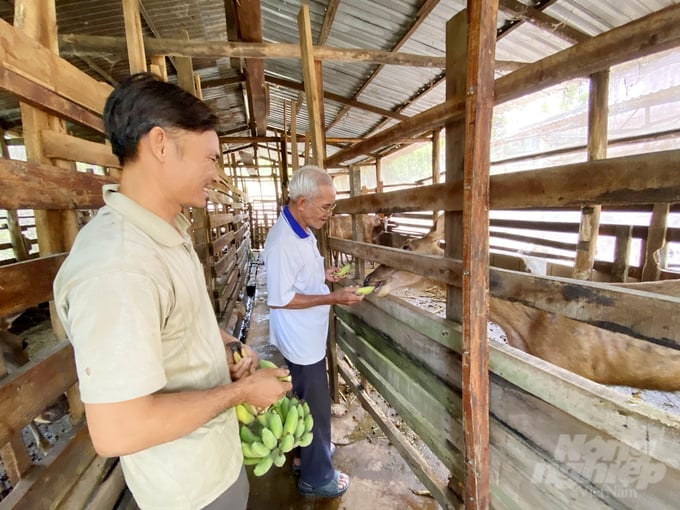
Mr. Nguyen Duy Man, from An Hao commune, Tinh Bien town (An Giang), is a household that raises deer for velvet antlers and sells them year-round. Photo: Le Hoang Vu.
Compared to many other localities in the country, the forest area in An Giang is not extensive, but it holds strategic importance for national defense and contributes to balancing the ecological environment in the region. The Bay Nui area is not only home to more than 30,000 households in Tri Ton district and Tinh Bien town, nearly half of whom are Khmer ethnic people.
Currently, with the reforestation of the Bay Nui area, wildlife farming under the forest canopy is considered a main source of income for many households. Mr. Nguyen Duy Man's family, residing in An Hao commune, Tinh Bien town, owns more than 15 hectares of forest land, including star trees, eucalyptus, mahogany, and acacia, extending from the base to the top of Cam Mountain. His family also raises deer for velvet antler harvesting throughout the year.
Mr. Nguyen Duy Man was the first household in An Hao commune to receive a loan supported by the An Giang Forest Protection Department in the form of a pair of deer for households with large forest areas, with a repayment period and interest rate after three years. This approach was intended to help residents in the Bay Nui area improve their living standards. However, for Mr. Man’s family, after only two years of raising deer, they reproduced and he sold the fawns, allowing him to recover his capital and make a profit. Now, his deer herd has grown to nearly 20, generating an annual income of about 120-150 million VND from selling velvet antlers.
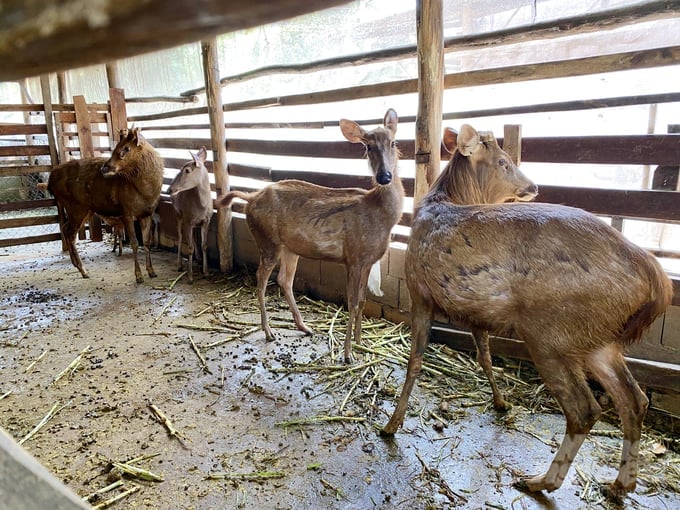
Thanks to raising deer under the forest canopy, Mr. Man's deer herd has now grown to nearly 20. On average, he earns about 120-150 million VND annually from selling velvet antlers. Photo: Le Hoang Vu.
According to Mr. Man, deer are very easy to raise and care for, with few illnesses. They only need to be fed 2-3 times a day, and their drinking water should be mixed with a bit of salt or bran to ensure sufficient nutrition. The deer's diet mainly consists of wild grasses or elephant grass grown under the forest canopy, along with agricultural by-products such as corn husks and stalks, water spinach, and sweet potatoes, which are readily available in local markets.
When they reach maturity, female deer can start reproducing at 25 months old and give birth to one fawn each year. Male deer begin producing velvet antlers at 17-18 months, with the harvesting season from April to August (lunar calendar). The first harvest yields only 500-600 grams of velvet, but from the fifth harvest onward, each deer consistently produces about 2.5 kilograms of velvet. Currently, 1 kilogram of velvet antlers sells for 14-15 million VND.
Anh Chau Vui, residing in Ro Leng hamlet, Chau Lang commune, Tri Ton district, shared that previously, apart from the annual financial support from the forestry sector for planting, caring for, and protecting 1 hectare of forest, his family mainly lived off a few plots of crops grown under the forest canopy. In recent years, as the forest trees have grown dense and it is no longer possible to cultivate crops, he and many Khmer people in the area have switched to raising cattle for fattening.
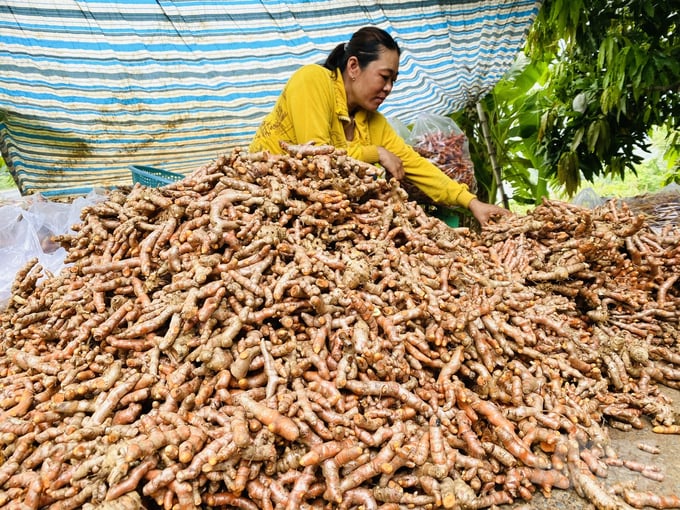
The people in the Bay Nui region (An Giang) harvest golden turmeric roots for medicinal purposes. Photo: Le Hoang Vu.
Besides raising cattle for fattening, his family also has a cattle farm with dozens of cows. They are hopeful that by the end of this year, they will have a substantial income from selling this new batch of beef cattle.
In addition to selling velvet antlers, Mr. Man's family sells 1-2 pairs of young deer each year for breeding purposes. On average, a 6-month-old pair of young deer sells for 40-50 million VND.
In addition to raising wildlife and cattle under the forest canopy, in recent years, the implementation of plans for the conservation and development of medicinal plants grown under the forest canopy has led the An Giang Provincial Management Board of Protective and Special-use Forests to establish many cooperatives for forest protection and medicinal plant cultivation to help people increase their economic income.
Moreover, the Department of Science and Technology and the Department of Agriculture and Rural Development have conducted dozens of research projects on medicinal plants to assist people in developing production under the forest canopy and building brands for some key products such as Ngu Ho Son – Bao Lam black bean powder, Ngu Ho Son ginseng liquor, yellow turmeric, red turmeric, Morinda officinalis, Fallopia multiflora, Desmodium styracifolium, Dracaena cambodiana, Houttuynia cordata, and pink ginseng.
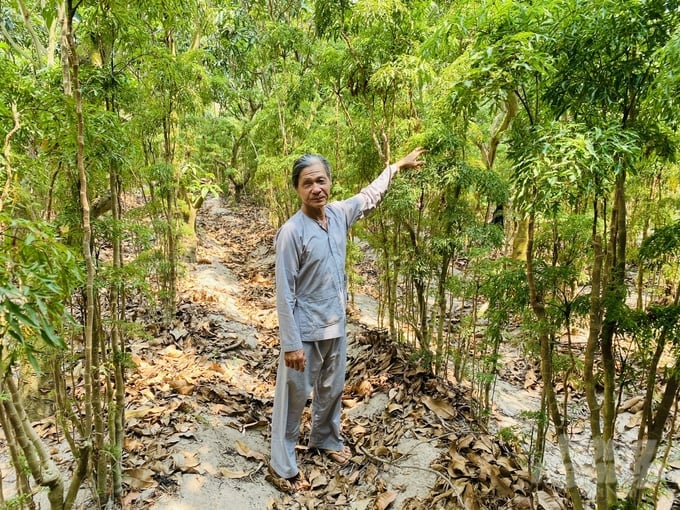
Mr. Nguyen Minh Duc utilizes growing medicinal plants such as Polyscias fruticosa, black ginger, and Codonopsis pilosula to increase income. Photo: Le Hoang Vu.
Mr. Nguyen Minh Duc, residing in Nui Ket hamlet, Thoi Son commune, Tinh Bien district, shared that his family owns 5 hectares of forest. Under the forest canopy, he has utilized the space to grow medicinal plants such as black bean, black turmeric, and Polyscias fruticosa. These plants thrive well under the forest canopy, providing his family with a stable annual income from these medicinal plants.
Mr. Thai Van Nhan, from the An Giang Provincial Management Board of Protective and Special-use Forests, noted that currently, people in the Bay Nui area are actively developing various economic activities under the forest canopy, including animal husbandry, crop cultivation, services, and eco-tourism. These models are considered highly effective and should be expanded within the community and among households contracted to manage the forest.
Translated by Mai Quang Huy
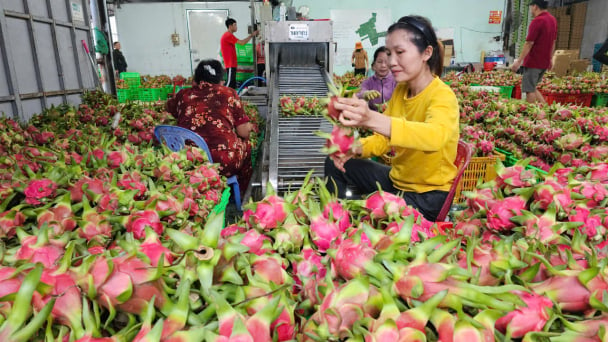
(VAN) According to the Binh Thuan Department of Industry and Trade, in the first five months of 2025, Binh Thuan's dragon fruit export turnover increased by 20.65% compared to the same period last year.
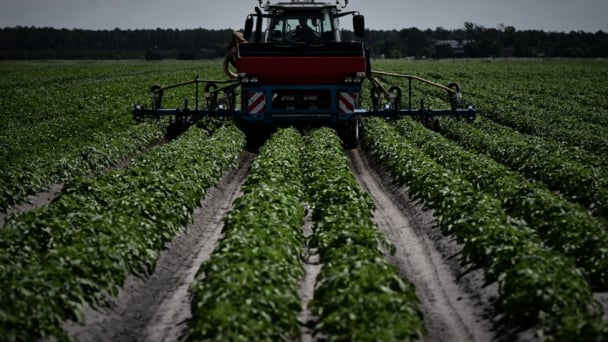
(VAN) EU countries on Thursday gave final approval to new tariffs on fertilizer imports from Russia, a move aimed at cutting off revenue that could support Moscow’s war in Ukraine, despite concerns from European farmers.

(VAN) The working delegation from the Ministry of Agriculture and Environment conducted an important trip to the Netherlands to strengthen strategic partnerships and sustainable development in the agricultural sector.

(VAN) The letter ‘A Plea from the Ocean’ not only evokes emotion but also awakens the human conscience to the responsibility of protecting life on Earth.

(VAN) The Department of Agriculture in South Africa has announced the country’s first mass vaccination of poultry to prevent local birds from contracting avian influenza.

(VAN) Establishment of the Mekong Delta Regional Agricultural Linkage Center, aiming for a closed value chain, deep processing, trading platforms, and international market connectivity.

(VAN) Gia Lai province has recently recorded 460 rare species of animals and plants, contributing to forest conservation and biodiversity planning in the region.